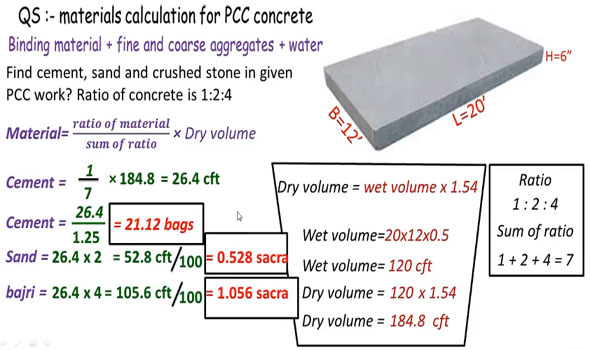How to compute materials in Plain Cement Concrete
- Concrete Cost Estimator
- Concrete Continuous Footing
- Landscape Bidding and Estimating
- Construction Cost Estimating
- Concrete and steel cost estimation
- Construction Cost Estimate Breakdown
- Construction Estimating Worksheet
- Home Construction Cost Estimate
- Estimate Pricing Sheet
- Sheet for General Contractor
- Construction Cost Estimate
- Labor Materials Cost Estimator
- Masonry Estimating Sheet
- Sheet for Building Contractor
- Construction Schedule Bar chart
- General Cost Estimator Sheet
- General Construction Estimate
- Building and Road Estimating Sheet
- Detailed expense estimates
- Door and Window Takeoff Sheet
- General Construction Cost Estimating Sheet

This construction video will briefly teach you how to measure the binding material, fine and coarse aggregates determination for Plain Cement Concrete (PCC). Initially, the estimation is made for cement then sand and finally for crushed stone.
Plain Cement Concrete (PCC) refers to the construction material that is usually applied as the binding materials. It is formed with cement, (generally Portland Cement) and other cementitious materials like fly ash and slag cement, aggregate (normally a coarse aggregate) created with gravels or crushed rocks like limestone or granite, along with a fine aggregate like sand as well as water, and chemical admixtures.
Plain cement concrete (PCC) is useful for delivering inflexible water-resistant bed to RCC in foundation where the earth is soft and resilient. PCC is applied over brick flat soling or without brick flat soling.
Plain cement concrete is also known as "cement concrete (CC)" or "binding concrete".
Materials required for forming PCC:
Cement: Usually the Portland cement is applied as bonding material in PCC.
Fine Aggregate: Sand is applied as fine aggregate. The FM of sand should be 1.2 to 1.5.
Course Aggregate: Generally brick chips are utilized for developing PCC. Stone chips are also applied for this purpose. The size of the course aggregate is 20mm downgrade.
Water: Clean water that is safe to drink should be utilized in PCC.
The following formula is applied for this :-
Material = ratio of material/sum of ratio x dry volume
Suppose the ratio of cement, sand and crushed stone is 1:2:4
To calculate dry volume, the formula will be wet volume x 1.54
Wet volume = Length x Breadth x Thickness
Video Source: SL Khan

- Application of concrete calculator
- Roofing Calculator can streamline the roof estimating process
- House construction cost calculator
- Engineering column design excel spreadsheet
- Material Estimating Sheet with Excel
- Materials List and Cost Estimate Worksheet
- Concrete Slab Estimating Calculator Sheet
- Common types of foundations for buildings
- Online calculation of construction materials
- Estimating with Excel for the Small Contractor
- Concrete Beam Design Spreadsheet
- Virtual Construction Management app for construction
- Autodesk’s Project Skyscraper
- Reed Construction’s Reed Insight
- Manage your construction project documentation
- Costimator, the popular cost estimating software
- On Center Software for construction professionals
- Free Construction Estimating Software
- Plumbing Calc Pro
- Cost Estimate Worksheet
- HVAC Piping Quantity Takeoff Worksheet
- Construction Estimating Software Sheet
- Estimate Cost Templates
- Construction Punch List
- Construction cost estimating template consisting estimating basic
- Gantt Chart Template for Excel
- Download Civil Engineering Spreadsheets with Verification
- The Building Advisor Estimating and Budgeting Worksheet
- Spreadsheet for design of concrete bridge
- Construction Estimating Software Free








